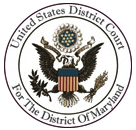Top Qs
Timeline
Chat
Perspective
United States District Court for the District of Maryland
United States district court From Wikipedia, the free encyclopedia
Remove ads
The United States District Court for the District of Maryland (in case citations, D. Md.) is the federal district court whose jurisdiction is the state of Maryland. Appeals from the District of Maryland are taken to the United States Court of Appeals for the Fourth Circuit (except for patent claims and claims against the U.S. government under the Tucker Act, which are appealed to the Federal Circuit).
Remove ads
Notable past judges of this district include William Paca, a signer of the United States Declaration of Independence. The United States Attorney for the District of Maryland represents the United States in civil and criminal litigation in the court. As of October 7, 2021[update], the U.S. attorney is Erek Barron.[1]
Remove ads
Organization of the court


Under 28 U.S.C. § 100, Maryland consists of a single federal judicial district with two statutory divisions.
Northern Division
The Northern Division includes Allegany, Anne Arundel, Baltimore, Caroline, Carroll, Cecil, Dorchester, Frederick, Garrett, Harford, Howard, Kent, Queen Anne's, Somerset, Talbot, Washington, Wicomico, Worcester counties and the City of Baltimore, is located in Baltimore, while the statute also provides for the court to sit in Cumberland and Denton. The Court also maintains a location in Salisbury, Maryland that is only staffed on days when court is in session.[2]
Southern Division
The Southern Division includes Calvert, Charles, Montgomery, Prince George's, and St. Mary's counties and sits in Greenbelt.
Remove ads
Current judges
Summarize
Perspective
As of January 11, 2025[update]:
Remove ads
Former judges
- Recess appointment; formally nominated on February 8, 1790, confirmed by the United States Senate on February 10, 1790, and received commission the same day.
- Recess appointment; formally nominated on January 3, 1820, confirmed by the Senate on January 5, 1820, and received commission the same day.
- Recess appointment; formally nominated on December 16, 1824, confirmed by the Senate on January 3, 1825, and received commission the same day.
- Recess appointment; formally nominated on December 19, 1853, confirmed by the Senate on January 11, 1854, and received commission the same day.
- Recess appointment; formally nominated on December 6, 1927, confirmed by the Senate on December 19, 1927, and received commission the same day.
- Recess appointment; formally nominated on December 15, 1931, confirmed by the Senate on January 12, 1932, and received commission the same day.
- Recess appointment; formally nominated on January 12, 1956, confirmed by the Senate on March 1, 1956, and received commission on March 2, 1956.
- Recess appointment; formally nominated on January 15, 1962, confirmed by the Senate on February 7, 1962, and received commission on February 17, 1962.
Remove ads
Chief judges
Chief judges have administrative responsibilities with respect to their district court. Unlike the Supreme Court, where one justice is specifically nominated to be chief, the office of chief judge rotates among the district court judges. To be chief, a judge must have been in active service on the court for at least one year, be under the age of 65, and have not previously served as chief judge.
A vacancy is filled by the judge highest in seniority among the group of qualified judges. The chief judge serves for a term of seven years, or until age 70, whichever occurs first. The age restrictions are waived if no members of the court would otherwise be qualified for the position.
When the office was created in 1948, the chief judge was the longest-serving judge who had not elected to retire, on what has since 1958 been known as senior status, or declined to serve as chief judge. After August 6, 1959, judges could not become or remain chief after turning 70 years old. The current rules have been in operation since October 1, 1982.
Remove ads
Succession of seats
Summarize
Perspective
Remove ads
U.S. Attorneys
- Richard Potts 1789–92 [3]
- Zebulon Hollingsworth 1792–1806
- John Stephen 1806–10
- Thomas B. Dorsey 1810–12
- Elias Glenn 1812–24
- Nathaniel Williams 1824–41
- Z. Collins Lee 1841–45
- William L. Marshall 1845–50
- Z. Collins Lee 1850–53
- William M. Addison 1853–62
- William Price 1862
- Archibald Sterling, Jr. 1878–86
- Thomas Gordon Hayes 1886–90
- John T. Ensor 1890–94
- William L. Marbury 1894–98
- John C. Rose 1898–1910
- John Philip Hill 1910–15
- Samuel K. Dennis 1915–20
- Robert R. Carman 1920–22
- Amos W. W. Woodcock 1927–31
- Simon E. Sobeloff 1931–34
- Bernard J. Flynn 1934–53
- George C. Doub 1953–56
- Walter E. Black, Jr. 1956–57
- Leon H. A. Pierson 1957–61
- Joseph D. Tydings 1961–63
- Robert H. Kernon 1963
- Thomas J. Kenney 1963–67
- Stephen H. Sachs 1967–70
- George Beall 1970–75
- Jervis S. Finney 1975–78
- Russell T. Baker 1978–81
- Herbert Better 1981
- J. Frederick Motz 1981–85
- Catherine C. Blake 1985–86
- Breckinridge L. Willcox 1986–91
- Richard D. Bennett 1991–93
- Gary P. Jordan 1993
- Lynne Ann Battaglia 1993–2001
- Stephen M. Schenning 2001[4]
- Thomas M. DiBiagio 2001–2005
- Allen F. Loucks 2005[5]
- Rod Rosenstein 2005–2017
- Stephen M. Schenning 2017–2018
- Robert Hur 2018–2021
- Erek Barron 2021–2025
- Phil Selden (acting) 2025
- Kelly O. Hayes (interim) 2025–
Remove ads
See also
References
External links
Wikiwand - on
Seamless Wikipedia browsing. On steroids.
Remove ads


